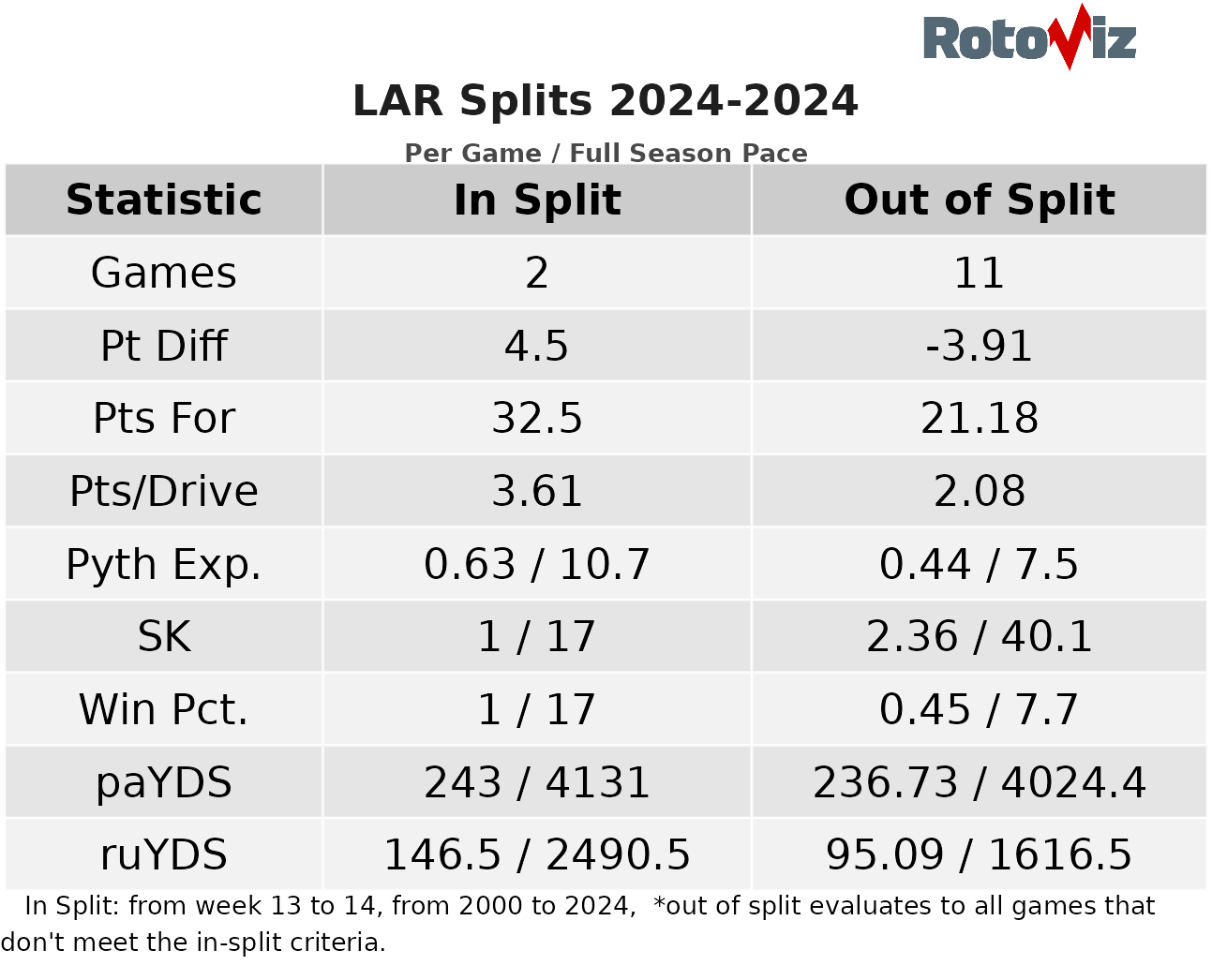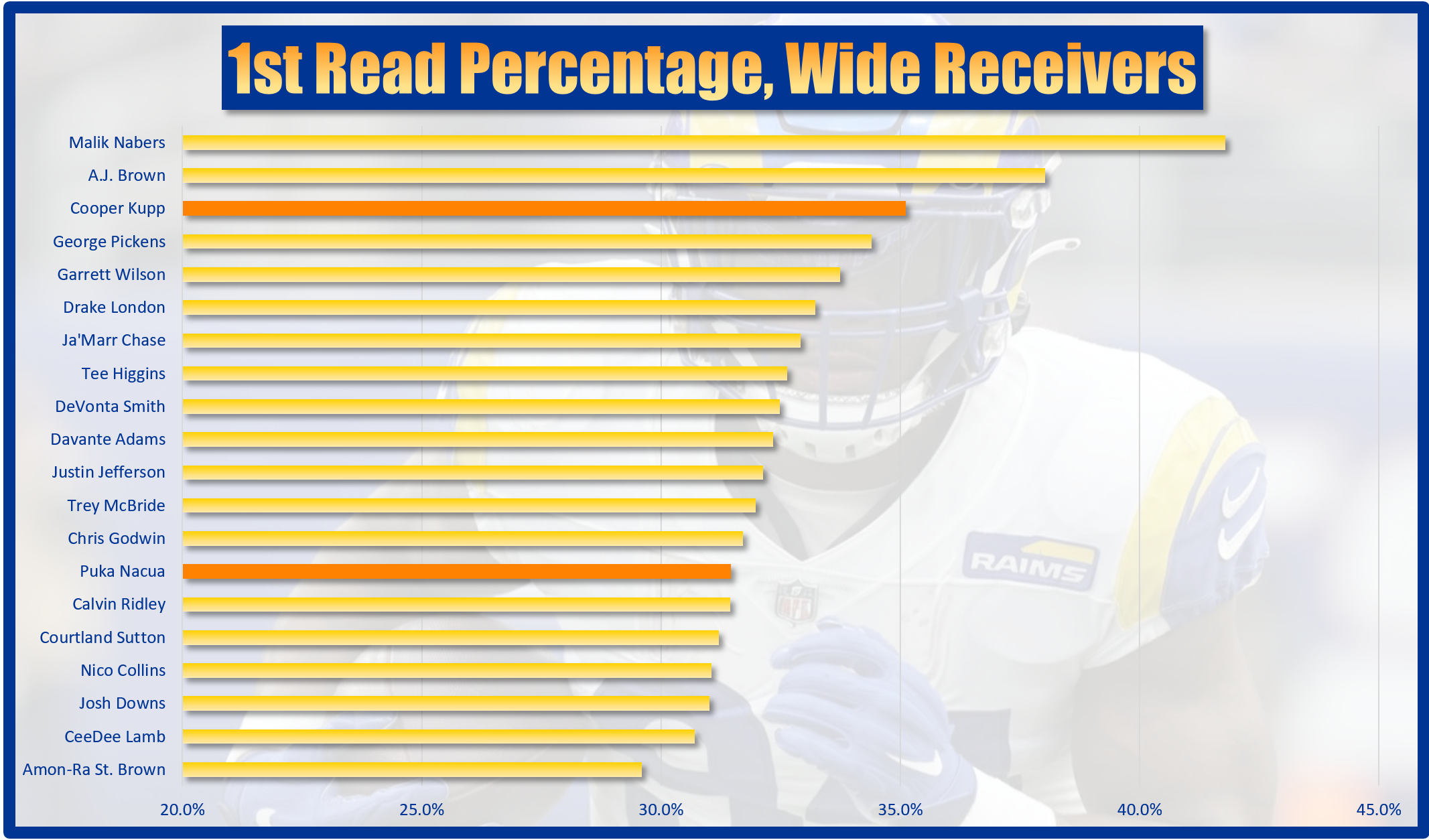
Quick Slant: TNF - Anything You Can Do I Can Do Better
Rams @ 49ers, Thursday @ 8:15 PM
Sean McVay and Kyle Shanahan, two rivers flowing from the same spring, were once apprentices in the erudite playbook of Mike Shanahan, Kyle’s father, the architect of the zone-blocking scheme that reshaped the tenets of 100 years of offensive football. Soon after, Shanahan and McVay would carve through the soil and regolith, cutting a new path borne of the same vivifying waters. McVay eventuated in Southern California; and Shanahan in Northern, flanking the I-5 along one of the world's most influential stretches of real estate. By now, they’ve immortalized their own legacies; from them have sprouted new tributaries. Nearly half of the NFL’s play-callers today can reasonably be traced back to one of these two men or Father Shanahan himself.
The LA Rams now signify the chic neon culture of America’s Babylon, but they once represented Northern Ohio. In 1946, they traded the ingots and iron of Cleveland’s unfeeling bridges for the laurel-festooned halls of the LA Colosseum, became front-runners for racial integration, and advanced the league’s use of the forward pass. Even when they vacationed in Missouri for two decades, The Greatest Show on Turf felt miscast in the Midwest; for all intents and purposes, it could have captured the fast-paced lifestyle of DTLA. Upon their reversion to LA and brighter royal blue and yellow, the Rams called a shimmering glass Burj Khalifa of a venue home. And in that very building, they won it all in 2022, justifying McVay as more than a curator of twinkle and glitz. He would be forever great.
The San Francisco 49ers are known success. With five sterling silver emblems of their dominance displayed in their trophy case, they have won more Lombardis than all but three teams. But, strange as it is, the 49ers are also icons for the almost. From their Falcons-esque collapse in the 1957 NFL Championship playoffs where they blew a 24-7 halftime lead, John Brodie running into the stone wall of Tom Landry’s Doomsday Defense in consecutive NFC Championships in ’70 and ’71, Minnesota’s shocking upset of the dominant 1987 squad, Roger Craig’s fateful fumble in 1990’s quest for three-peat, Kyle Williams’ gut-wrenching muffed punts in the 2011 NFC Championship, Richard Sherman’s fingertip dagger in 2014, and Patrick Mahomes arranging heartbreak in the waning minutes of two Super Bowls in five years. The Niners are as haunted by agonizing near-misses as they are fed by Jerry Rice, Joe Montana, and Steve Young’s salad days. Today, Shanahan orchestrates a similar existence; the loser of two Super Bowls and two other NFC Championship games, he has yet to be gratified by the falling of crimson and gold confetti.
This Thursday night, McVay’s 7-6 Rams travel north to Levi’s Stadium, where Shanahan’s 6-7 49ers await. Each has experienced an avalanche of setbacks, yet here they are, both within two games of first place in the NFC West. Forget the angles—Esau and Jacob, a chess game between geniuses, bitter rivals, the Kings of California—these two just need a win. That’s all the motivation they need.
Rams’ Implied Team Total: 23
The Rams seemed like a team on the verge of a leap in 2024; trust was high for McVay, Matthew Stafford, and Cooper Kupp, the post-Whitworth/post-championship offensive line had been rebuilt and stabilized, and a pair of young skill players emerged to take the league by storm in 2023. It seemed only logical LA had been repaired enough to retake its place as a perennial NFC contender guided by an intelligent play-caller who always has answers.
Instead, the adversities piled up. The Rams began with two-fifths of their starting offensive line; within two games, they had lost Kupp and Nacua. Stafford was like a man running from a spreading fire on every snap; their skill core was reduced to no-names and has-beens. And yet, they survived enough to arrive here at 7-6, including a win over their California bunkmates earlier this year.
According to Pythagorean Wins, the Rams are the league’s sixth most fortunate team, having gained nearly two additional wins over expected.

Perhaps this tells us nothing we didn’t already know; the Rams survived a string of games as a fraction of themselves. The point is that they are here now and are healthy once and for all. Try not to see them as the post-wreck Corolla with the check engine light aglow and trunk held closed by bungees and duct tape; think of them as the functional vessel we believed they would be this summer. This team didn’t put up these stats. This team just beat the Bills.
It wasn’t until Week 13 that the Rams even got Kupp, Nacua, and three in-and-out starting offensive linemen—Rob Havenstein, Alaric Jackson, and Steve Avila—on the field at once. In two games with all five together, the Rams have scored over 11 more points/G, allowed almost 1.5 fewer sacks, and had better yardage outputs than averages from Weeks 1-12. The sample size is small, but this Rams offense looks far more aligned with what we expected.

Havenstein and Avila couldn’t get on the field at the same time between Weeks 8-12, but one of the two has been available since Week 8. With four of the five available in each game since then, the Rams’ improvement is notable.

For the season, the Rams rank 11th in EPA per play and 6th in offensive success rate.

They rank 11th in EPA per dropback and 5th in offensive success rate on dropbacks. They are slightly worse as a rush offense, ranking 15th in EPA per rush and eighth in offensive success rate on rushes.
We should toss out the first seven games to give proper justice to the Rams. Studying only games since Week 8, we see that they rank tied for eighth in neutral run rate, and close to the league average in neutral seconds to snap at 28.3. They rank third in the league since Week 8 in total plays at 466, giving them massive fantasy appeal.
Since that time, the Rams players we care about have generally produced in fantasy. Matthew Stafford ranks 10th among QBs with 22.14 PPR/G, Nacua ranks 4th among WRs with 20.59, Kupp ranks 7th with 18.0, and Kyren Williams ranks 16th among RBs at 15.73.
Since then, Stafford ranks 6th in passing attempts/G and passing yards/G and has thrown the second-most TDs/G. Stafford ranks 7th in EPA + CPOE composite since Week 8.

The Rams remain super concentrated on offense, especially in the passing game. In the last six games, only two players have at least a 15% market share: Nacua (31%) and Kupp (28%). Kyren Williams hasn’t been getting the share we might desire. Williams ranks 34th in market share among RBs since Week 8.

This isn’t a usage problem. Williams has been on the field for 74% of the Rams’ snaps since Week 8, fifth among RBs. In Weeks 1-7, Williams ran a route on 64.4% of the Rams’ dropbacks; In Weeks 8-14, he ran a route on 62.5%. His participation hasn’t changed; what has changed is that Kupp and Nacua, two of the NFL’s best WRs, frequently make for more attractive targets than Williams when they are all playing.
With such high pass volume and target shares, it is unsurprising that Nacua (5th) and Kupp (11th) each rank in the top 12 in targets/G since Week 8. Nacua, in particular, has been terrific, ranking eighth in EP, first in Y/RR, first in first downs/RR, and seventh in forced missed tackles, despite playing in only eight games; each is an excellent predictor of impending upside.
Of course, we don’t have to wait for it; Nacua has left two games very early—once for injury, and once for an ejection—leaving just six complete games. Of those, he has been a WR2 or better each week, and a WR1 in four, including this week’s 41.8 PPR effort against Buffalo.
Kupp has eight complete games; of those, he has been a WR2 or better six times and a WR1 four, including 32 PPR in Week 1, which finished second. Kupp ranks third in first-read target percentage, and Nacua ranks 14th.



